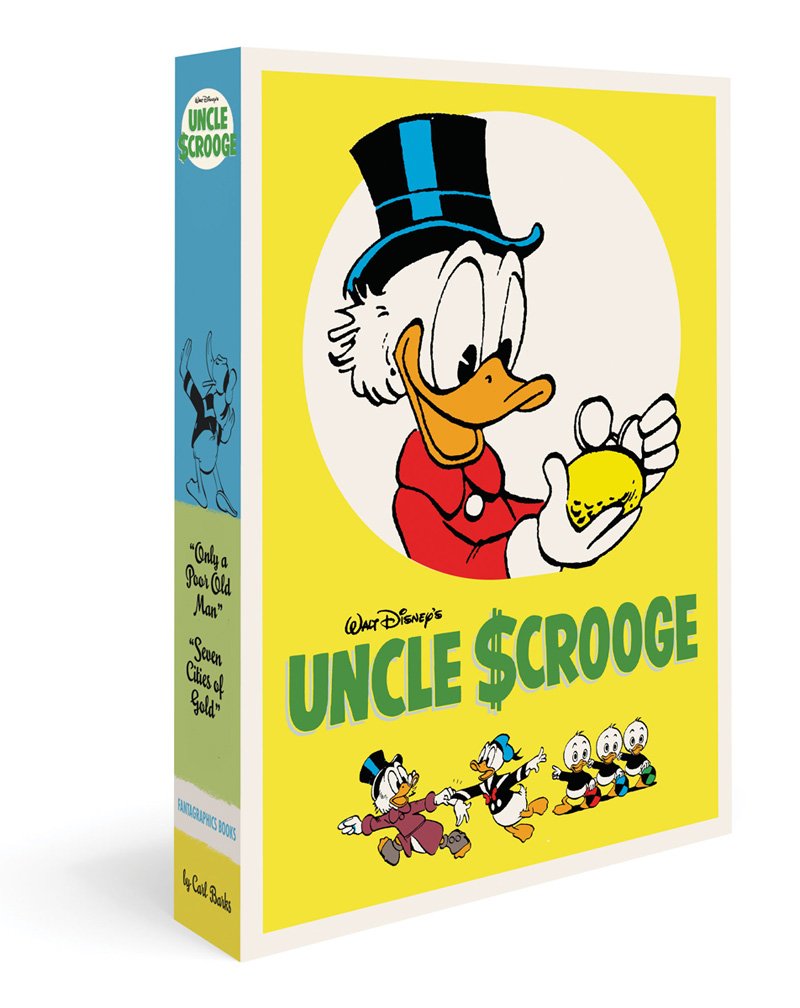
There are only a few comic creators for whom it can truly be said that they had an eternal impact on pop culture. Stan Lee, Jack Kirby and Steve Ditko for Sure, but another name looms above them and that is Carl Barks. Carl Barks, known to many as “The Good Duck Artist”, created some of the greatest stories of the ’40s ’50s, and ’60s and gave us countless hours of fun and imagination. He also gave us memorable characters like Gladstone Gander, Gyro Gearloose and the Junior Woodchucks. These characters all pale in comparison, however, to his most well-known creation: Scrooge McDuck.
Barks created Scrooge for his 1947 story, “Christmas on Bear Mountain”, where the character served the role of an Ebenezer Scrooge stand-in ( hence the name). A bitter old miser who hated everyone, but who came to love his family by the end of the story. Something stood out about Scrooge and he went from a one-off character to serving as the catalyst for many adventures for Donald Duck and his nephews. Scrooge was often a villainous figure at first and did many things that would later be completely out of character for him to do (such as being a robber baron). Over time, however, Barks would change the character of Scrooge to that of an adventurous spirit for whom every bit of coin had a story of one of his adventures. The transition culminated in the character getting his own series of comics to star in.
This volume ( 12th in the Fantagraphics collections) contains some of the best Uncle Scrooge stories, and also two of the most important. “Only A Poor Old Man” served as a bit of an origin for Uncle Scrooge, establishing his emotional connection to his money, how every bit of it has a memory for him and goes on to share some of those moments such as his time as a miner in the klondike. The story itself is a conflict between Scrooge, Donald, and the nephews, against the terrible Beagle Boys who are once again trying to steal Scrooge’s money. No spoilers will be given here, but the story shows Scrooge’s inventiveness and also points out the absurdity of swimming in money decades before it became a joke that you would hurt yourself that way. It also established a saying for Scrooge, that he made his money by being tougher than the toughies and smarter than the smarties and he made it fair. This is something that stands in contrast to earlier stories like “Voodoo Hoodoo” and shows that Barks now viewed the character differently.
“Back To The Klondike” is the other major story here and contains more of Scrooge’s origins and how he first became rich in the Klondike gold rush in the 1890s and of the woman he met there, Glittering Goldie. This story is notable for having been censored originally, where a lengthy flashback scene of Scrooge in a bar brawl and winning was removed for decades until the art was later restored for all to see. This is a different Scrooge, the character that would be dubbed by Don Rosa as the “King of the Klondike” an adventurer in his prime who struck it rich but dealt with others who would take advantage. Glittering Goldie stands out as a character who clearly meant much to Scrooge (again no spoilers for the story) and whose impact would be continued by many later writers, most notably Don Rosa.
While not as prominent as the first two stories I mentioned, “The Horse-Radish Treasure” is another classic. Scrooge and his nephews must find a sunken case of horse-radish and deliver it to Jamaica in order to keep his fortune. This story establishes some new backstory for clan McDuck and would be continued to be built on by later writers. It is an excellent story in its own right though, showcasing the protagonists navigating a dangerous journey and facing treachery along with way.
The other stories within include the short story “Something Fishy Here” where a prank by Donald backfires on him. It was originally written and drawn quickly to replace the censored pages of “Back to the Klondike” but has a certain amount of charm. Also included is ” The secret of Atlantis” which is one of the weaker stories in this collection. It involves Scrooge’s efforts to make a quarter the most valuable coin in the world and quickly spirals out of his control and despite being a weaker story, is still quality work by Barks. In addition, there are several one-page gags that show off a different side of Barks’s writing, as he was able to build up and subvert expectations brilliantly, as well as craft hilarious jokes.
Lastly, there is “Tralla La La”, where Scrooge and his nephews journey to the village of the same name, a moneyless hidden paradise based in part on Shangri La and also an actual Himalayan village Barks read about, due to Scrooge suffering stress from dealing with his business. This story has some depictions of minorities that would be considered questionable today, but nowhere near the problems of some other stories. Scrooge causes problems when a bottle cap of his causes the village to go into disarray due to it introducing greed and desire to their village. The plot is actually similar to the movie “The Gods Must Be Crazy” albeit in a different way. Scrooge is not actively malicious and treats the villagers with respect, but trouble follows anyway. It is one of the more interesting reads in the book.
To sum up, Walt Disney’s Uncle Scrooge: Only a Poor Old Man is a great starting point for anyone wanting to read the work of the master Carl Barks. You get amazing stories and a true insight into the character of Uncle Scrooge and why he has endured for so long.

